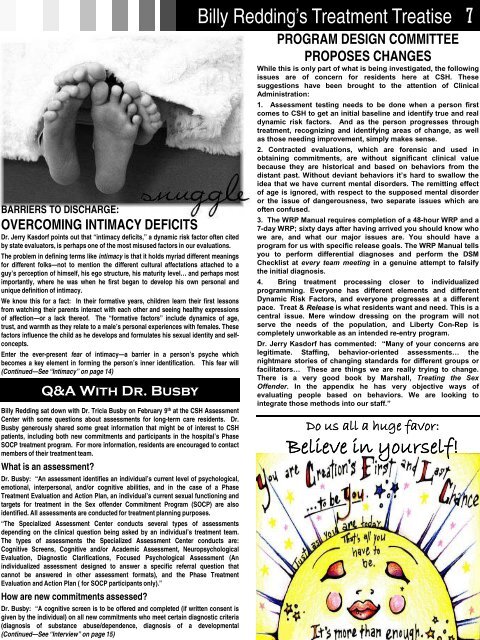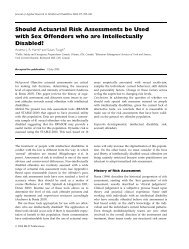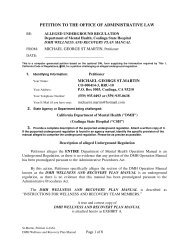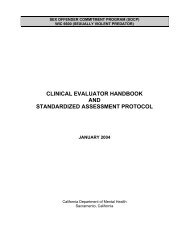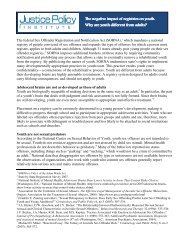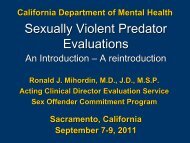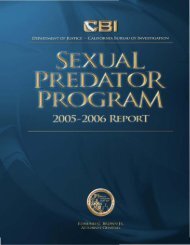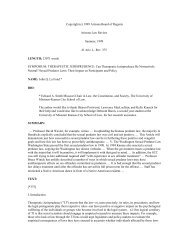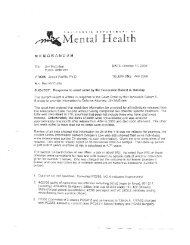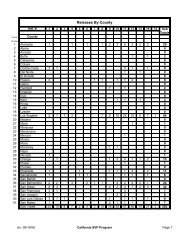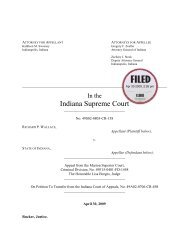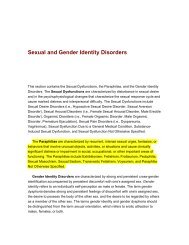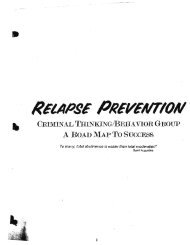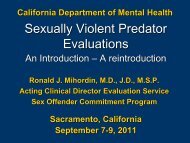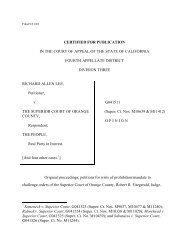UNCENSORED version of the March 2010 edition ... - Defense for SVP
UNCENSORED version of the March 2010 edition ... - Defense for SVP
UNCENSORED version of the March 2010 edition ... - Defense for SVP
Create successful ePaper yourself
Turn your PDF publications into a flip-book with our unique Google optimized e-Paper software.
BARRIERS TO DISCHARGE:<br />
OVERCOMING INTIMACY DEFICITS<br />
Dr. Jerry Kasdorf points out that “intimacy deficits,” a dynamic risk factor <strong>of</strong>ten cited<br />
by state evaluators, is perhaps one <strong>of</strong> <strong>the</strong> most misused factors in our evaluations.<br />
The problem in defining terms like intimacy is that it holds myriad different meanings<br />
<strong>for</strong> different folks—not to mention <strong>the</strong> different cultural affectations attached to a<br />
guy’s perception <strong>of</strong> himself, his ego structure, his maturity level… and perhaps most<br />
importantly, where he was when he first began to develop his own personal and<br />
unique definition <strong>of</strong> intimacy.<br />
We know this <strong>for</strong> a fact: In <strong>the</strong>ir <strong>for</strong>mative years, children learn <strong>the</strong>ir first lessons<br />
from watching <strong>the</strong>ir parents interact with each o<strong>the</strong>r and seeing healthy expressions<br />
<strong>of</strong> affection—or a lack <strong>the</strong>re<strong>of</strong>. The “<strong>for</strong>mative factors” include dynamics <strong>of</strong> age,<br />
trust, and warmth as <strong>the</strong>y relate to a male’s personal experiences with females. These<br />
factors influence <strong>the</strong> child as he develops and <strong>for</strong>mulates his sexual identity and selfconcepts.<br />
Enter <strong>the</strong> ever-present fear <strong>of</strong> intimacy—a barrier in a person’s psyche which<br />
becomes a key element in <strong>for</strong>ming <strong>the</strong> person’s inner identification. This fear will<br />
(Continued—See “Intimacy” on page 14)<br />
Q&A With Dr. Busby<br />
Billy Redding sat down with Dr. Tricia Busby on February 9 th at <strong>the</strong> CSH Assessment<br />
Center with some questions about assessments <strong>for</strong> long-term care residents. Dr.<br />
Busby generously shared some great in<strong>for</strong>mation that might be <strong>of</strong> interest to CSH<br />
patients, including both new commitments and participants in <strong>the</strong> hospital’s Phase<br />
SOCP treatment program. For more in<strong>for</strong>mation, residents are encouraged to contact<br />
members <strong>of</strong> <strong>the</strong>ir treatment team.<br />
What is an assessment<br />
Dr. Busby: “An assessment identifies an individual’s current level <strong>of</strong> psychological,<br />
emotional, interpersonal, and/or cognitive abilities, and in <strong>the</strong> case <strong>of</strong> a Phase<br />
Treatment Evaluation and Action Plan, an individual’s current sexual functioning and<br />
targets <strong>for</strong> treatment in <strong>the</strong> Sex <strong>of</strong>fender Commitment Program (SOCP) are also<br />
identified. All assessments are conducted <strong>for</strong> treatment planning purposes.<br />
“The Specialized Assessment Center conducts several types <strong>of</strong> assessments<br />
depending on <strong>the</strong> clinical question being asked by an individual’s treatment team.<br />
The types <strong>of</strong> assessments <strong>the</strong> Specialized Assessment Center conducts are:<br />
Cognitive Screens, Cognitive and/or Academic Assessment, Neuropsychological<br />
Evaluation, Diagnostic Clarifications, Focused Psychological Assessment (An<br />
individualized assessment designed to answer a specific referral question that<br />
cannot be answered in o<strong>the</strong>r assessment <strong>for</strong>mats), and <strong>the</strong> Phase Treatment<br />
Evaluation and Action Plan ( <strong>for</strong> SOCP participants only).”<br />
How are new commitments assessed<br />
Dr. Busby: “A cognitive screen is to be <strong>of</strong>fered and completed (if written consent is<br />
given by <strong>the</strong> individual) on all new commitments who meet certain diagnostic criteria<br />
(diagnosis <strong>of</strong> substance abuse/dependence, diagnosis <strong>of</strong> a developmental<br />
(Continued—See “Interview” on page 15)<br />
Billy Redding’s Treatment Treatise<br />
PROGRAM DESIGN COMMITTEE<br />
PROPOSES CHANGES<br />
While this is only part <strong>of</strong> what is being investigated, <strong>the</strong> following<br />
issues are <strong>of</strong> concern <strong>for</strong> residents here at CSH. These<br />
suggestions have been brought to <strong>the</strong> attention <strong>of</strong> Clinical<br />
Administration:<br />
1. Assessment testing needs to be done when a person first<br />
comes to CSH to get an initial baseline and identify true and real<br />
dynamic risk factors. And as <strong>the</strong> person progresses through<br />
treatment, recognizing and identifying areas <strong>of</strong> change, as well<br />
as those needing improvement, simply makes sense.<br />
2. Contracted evaluations, which are <strong>for</strong>ensic and used in<br />
obtaining commitments, are without significant clinical value<br />
because <strong>the</strong>y are historical and based on behaviors from <strong>the</strong><br />
distant past. Without deviant behaviors it’s hard to swallow <strong>the</strong><br />
idea that we have current mental disorders. The remitting effect<br />
<strong>of</strong> age is ignored, with respect to <strong>the</strong> supposed mental disorder<br />
or <strong>the</strong> issue <strong>of</strong> dangerousness, two separate issues which are<br />
<strong>of</strong>ten confused.<br />
3. The WRP Manual requires completion <strong>of</strong> a 48-hour WRP and a<br />
7-day WRP; sixty days after having arrived you should know who<br />
we are, and what our major issues are. You should have a<br />
program <strong>for</strong> us with specific release goals. The WRP Manual tells<br />
you to per<strong>for</strong>m differential diagnoses and per<strong>for</strong>m <strong>the</strong> DSM<br />
Checklist at every team meeting in a genuine attempt to falsify<br />
<strong>the</strong> initial diagnosis.<br />
4. Bring treatment processing closer to individualized<br />
programming. Everyone has different elements and different<br />
Dynamic Risk Factors, and everyone progresses at a different<br />
pace. Treat & Release is what residents want and need. This is a<br />
central issue. Mere window dressing on <strong>the</strong> program will not<br />
serve <strong>the</strong> needs <strong>of</strong> <strong>the</strong> population, and Liberty Con-Rep is<br />
completely unworkable as an intended re-entry program.<br />
Dr. Jerry Kasdorf has commented: “Many <strong>of</strong> your concerns are<br />
legitimate. Staffing, behavior-oriented assessments… <strong>the</strong><br />
nightmare stories <strong>of</strong> changing standards <strong>for</strong> different groups or<br />
facilitators… These are things we are really trying to change.<br />
There is a very good book by Marshall, Treating <strong>the</strong> Sex<br />
Offender. In <strong>the</strong> appendix he has very objective ways <strong>of</strong><br />
evaluating people based on behaviors. We are looking to<br />
integrate those methods into our staff.”<br />
Do us all a huge favor:<br />
Believe in yourself!<br />
7


